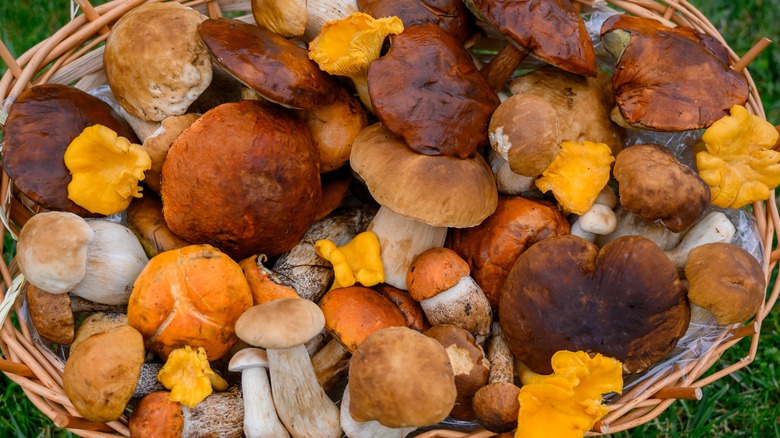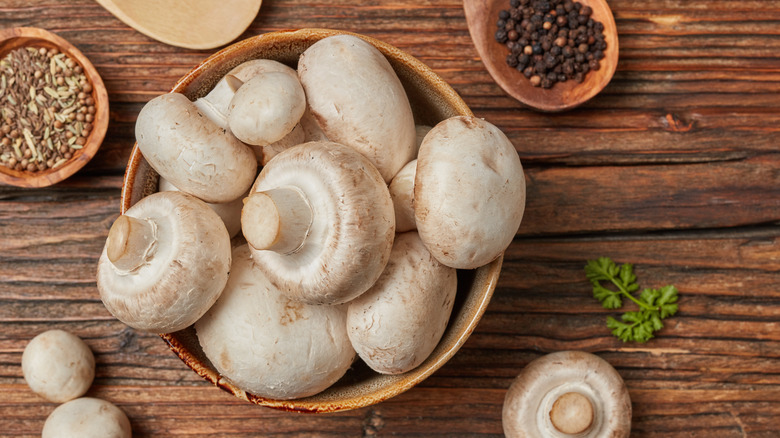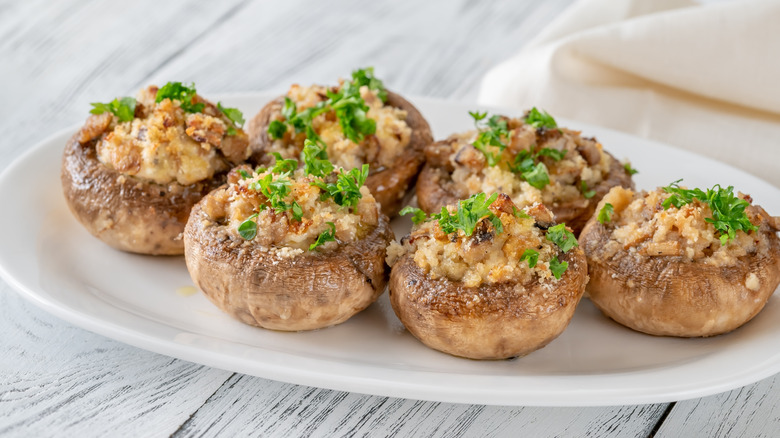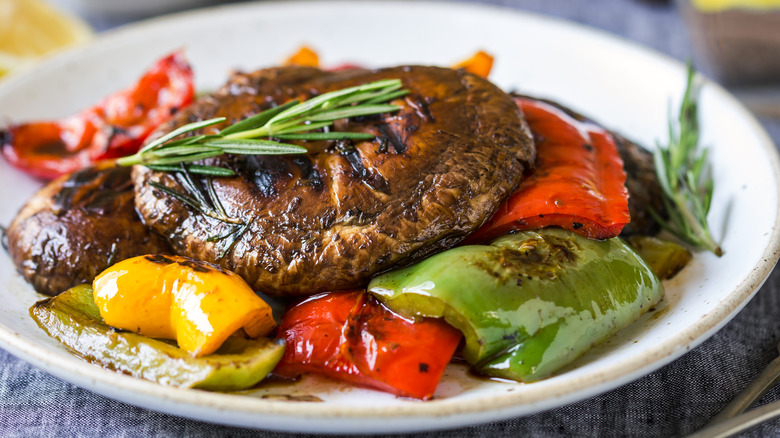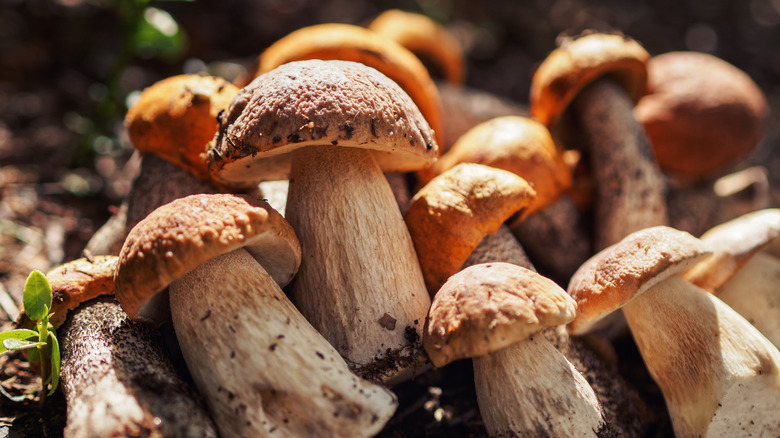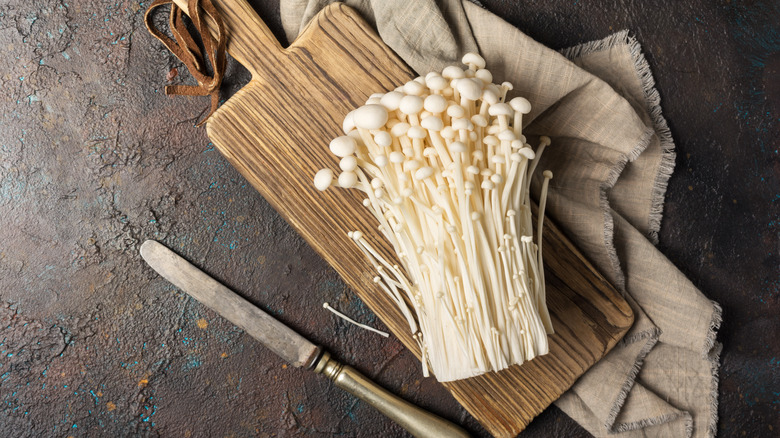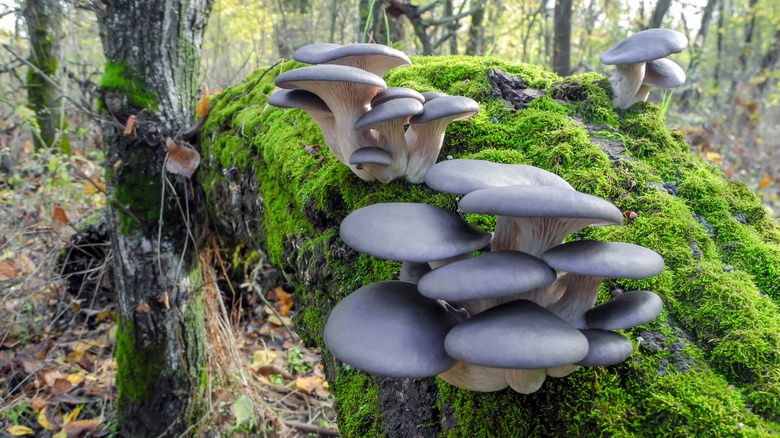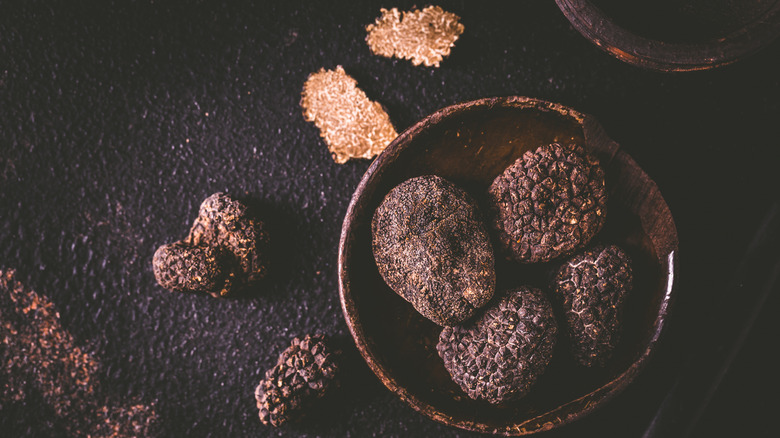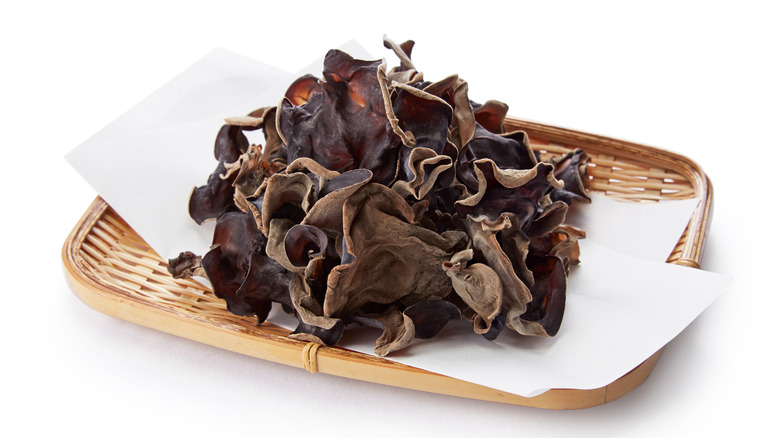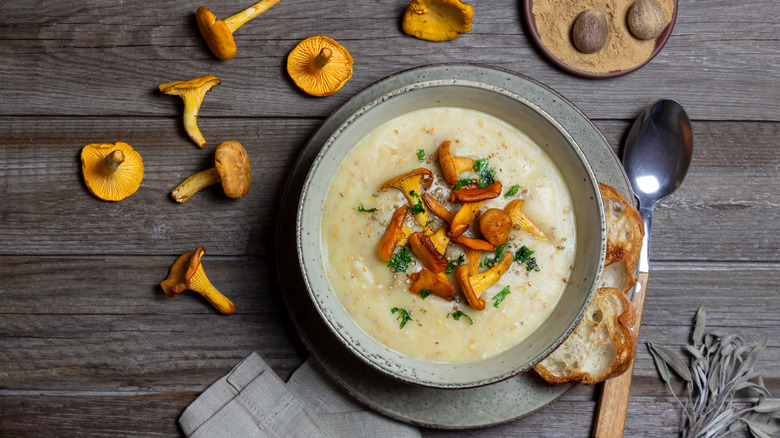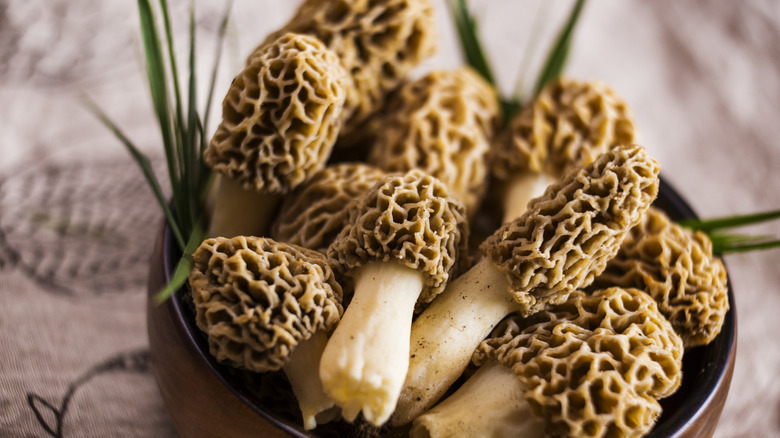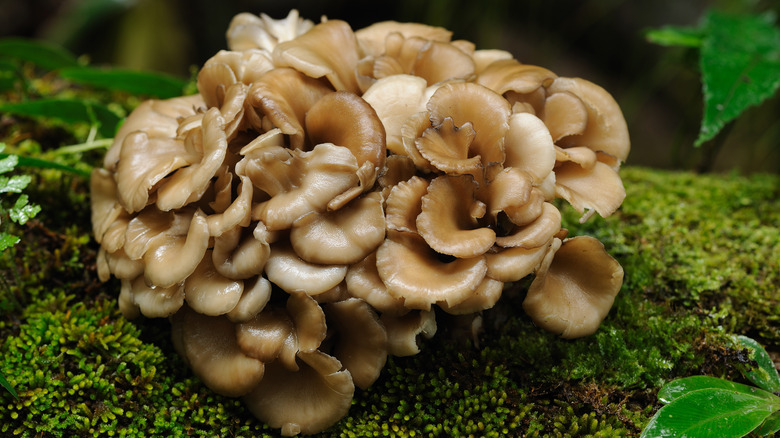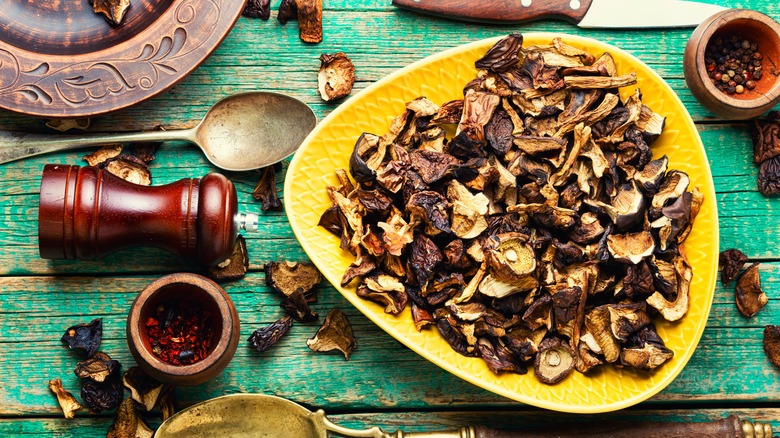13 Different Types Of Mushrooms And How To Use Them
Mushrooms are one of the most polarizing foods out there. Those who love them are obsessed with them. Those who hate them won't touch them with a 10-foot pole. And yet, it's not uncommon for people to gain an appreciation for mushrooms later in life, or to find that they actually enjoy a certain mushroom-based meal after swearing off the fungi completely. Perhaps it's not mushrooms that some people dislike, but how they're prepared.
Beyond the preparation factor, however, this phenomenon illustrates the diversity of mushrooms and how they don't all taste the same. In fact, according to the Bradbury Science Museum, while only 120,000 types of mushrooms have been identified, scientists estimate that there are anywhere from 2.2 to 3.8 million different varieties of mushrooms. Of these, approximately 2,006 species are safe to consume (via IFT). Of course, the knowledge of which mushrooms are safe and which are toxic is of the utmost importance. Unless you are an experienced mushroom forager, you should always consume mushrooms obtained through a licensed retailer or mycologist for your own protection.
Aside from the nutritional advantages of consuming mushrooms — like their high levels of antioxidants, and, in some cases, vitamin D (per UCLA Health) — these members of the fungi family are delicious additions to savory meals. Plus, they're pretty fascinating: In fact, mushrooms' DNA structures are more similar to those of humans than plants (via Farmers' Almanac). Let's take a look at some of our favorite mushrooms and how to prepare them.
1. Button mushrooms
The button mushroom is the most commonly available specimen of mushroom. A full 90% of mushrooms consumed in the U.S. are buttons, or champignon mushrooms, per Healthline. They are naturally low in calories, high in vitamin D2, high in protein, high in antioxidants, and may promote heart health. You can consume them raw or cooked, but ultimately the critical aspect of making these fungi delectable rests in how you approach them.
First, you should never soak them in water to clean them, but rather brush them clean with a damp paper towel to remove any loose dirt. There's a lot of debate about this, suggesting that because mushrooms are already 80% water, they don't actually absorb much liquid in the washing process (via Cook's Illustrated). However, they can develop a chewier, slimier texture after being washed, which is the chief complaint we hear from those who dislike mushrooms. Since cultivated button mushrooms are grown in special dirt that has been heat-treated to remove any pathogens, they are not likely to harbor bacteria (via PennState Extension).
We also go the extra step to peel button mushrooms, to help create a meatier and less gritty texture. If you remove the stem of each mushroom, you will notice a flap of skin on the interior of the cap. When you grab that flap with your thumb and index finger, you can easily remove the peel. Once peeled and cleaned, the mushrooms are ready for salads, stuffing, roasting, or sautéing.
2. Cremini mushrooms
Cremini mushrooms, or baby bellas, are actually the teenage version of a portobello mushroom, per WebMD. They tend to be bolder in flavor and slightly meatier in texture than the button, but not quite as replete with umami-forward flavors as the mature portobello. As with button mushrooms, creminis are nutrient-dense. It is also suggested that there is a link between the consumption of creminis and the proliferation of good bacteria in your gut, which can be instrumental in both immune support and better digestion.
In terms of how to handle creminis, they should be cleaned and peeled in the same way that button mushrooms are for the best quality flavor and texture. From there, they are ideal in almost any application, although we are particularly fond of using them in a sausage-stuffed mushroom recipe. The richness of their flavor is somewhat more suited to withstand the spices and fat content of sausage, and their slightly larger size makes them perfect as an appetizer you can just pop into your mouth. Pro tip: You can save the stems of button or cremini mushrooms for use in making a rich mushroom broth. Simply collect them in a Ziploc bag and freeze until you are ready to utilize them.
3. Portobello mushrooms
The most mature version of the Agaricus bisporus species of mushroom — which includes the button and the cremini — portobellos are one of only 10 varieties of mushroom cultivated commercially (via WebMD). Their distinct size and texture make them a popular mushroom to use in substituting meat for vegetarian and vegan recipes, although we maintain they are delicious in a variety of applications.
While you should handle the cleaning and peeling of portobellos the same way you do button and cremini mushrooms, you should take one additional step prior to using them. Because they have dense gills, scoop those gills out using a teaspoon. The gills can contribute to a chewier texture when cooked and can retain a somewhat unpleasant gritty feel.
As for the best ways to use portobellos, they can certainly be stuffed for a more hearty entree-sized portion, but we love them grilled and roasted. The application of intense heat allows them to caramelize, accentuating their robust flavor. Try seasoning them with an Alderwood or Hickory smoked sea salt after cooking to draw out even more of their umami notes. Another way to amp up their flavor is to marinate them in balsamic vinegar before roasting or grilling. Once cooked, you can use them on salads, as a simple side dish, a topping on a mushroom pizza, or even as a low-carb alternative to a burger bun.
4. Shiitake mushrooms
Often considered to be ubiquitous with Asian culinary tradition, the shiitake mushroom — or Lentinula edodes — is the third-most consumed fungus globally (via WebMD). It is native to areas throughout East Asia, but was first cultivated in China about 1,200 years ago. Its name comes from its legacy as a part of Japanese samurai culture. "Shii" is the type of hardwood tree they most often grow on, and "take" is the Japanese term for mushroom. Shiitake mushrooms today are obtained both in the wild and commercially cultivated utilizing wood-like vessels. The majority of cultivated shiitake mushrooms come from China.
Shiitake mushrooms are uniquely high in the mineral copper, which has been linked with good circulatory health, bone health, and increased immunity. It also has unusually high proportions of metabolism-boosting selenium. Rare cases of skin allergies have been attributed to the consumption of raw shiitake mushrooms relating to the presence of the compound lentinan. The process of cooking them neutralizes this compound.
To cook them, simply brush the mushroom caps clean with a damp cloth, and remove any woody stems. Their ultra-rich umami flavor makes them a favorite in Asian stir-fries, as well as a quintessential element in a classic hot and sour soup. And while not typical in Italian cuisine, they are a perfect accompaniment to a rich risotto or a creamy pasta dish, like a fettuccine alfredo.
5. Porcini mushrooms
According to Mushroom Appreciation, while the porcini mushroom is most commonly associated with Italy, it can be found throughout Europe, North America, New Zealand, and South Africa. These mushrooms are called mycorrhizal, meaning that they create a symbiotic relationship with the roots of plants generally found in hardwood forests composed of pine, chestnut, hemlock, and spruce trees. You can typically source them from late summer to fall, although they are often sold year-round in a dehydrated format. When purchasing fresh, you may find them labeled under one of their many monikers, including the king bolete, cèpe, or Steinpilz. Their name, "porcini," translates to "piglets" in Italian, presumably because of the appearance of their dense, sturdy stems.
A peculiarity of their makeup is that they are highly susceptible to being infested with tiny worms. To rid them of the worms, store the mushroom cap side-down which will encourage the worms to eat their way to the top of the stems. At this point, you can brush the mushrooms off with a damp cloth and cut the end of the stem off. They can then be chopped and incorporated into any of your favorite recipes.
You can add a pinch of freshly grated nutmeg to these recipes. The hint of spicy sweetness in the nutmeg makes the quintessential nuttiness of the porcini pop gloriously, especially in a mushroom cream sauce or a thick mushroom soup. Garnish with a bit of freshly grated parmesan cheese and your mouth will be dancing with delight.
6. Enoki mushrooms
Also known as enokitake, winter mushrooms, velvet shank, or golden needle mushrooms, the enoki mushroom is another mushroom that is often associated with Asian cuisine (via WebMD). Enokis can be found in the wild growing on the surface of dead elm trees or can be cultivated using a pseudo tree branch composed of sawdust, corn cob, rice bran, and other materials. The wild varietal is often golden in color thanks to the kiss of sunlight giving it a tan, while the commercially grown varietal is white thanks to it being grown indoors in an environment void of sunlight.
This particular mushroom is uniquely susceptible to becoming contaminated with the bacteria Listeria monocytogenes, which can cause serious food-borne illness. It is therefore recommended that these mushrooms be meticulously washed, their stems removed, and then thoroughly cooked before consuming them. Their unique spaghetti-like strand composition gives them a distinct texture when added to a dish, and their flavor is somewhere between sweet and savory, making them a stellar addition to an Asian noodle dish or hot pot.
Enoki mushrooms are particularly rich in fiber and antioxidants known as phenols and polyphenols. This purportedly makes them powerful anti-inflammatories as well as potentially instrumental in improving brain function. Polysaccharides in these mushrooms have also been linked with regulating neurotransmitters like serotonin, dopamine, and norepinephrine, which could boost your memory and regulate your mood.
7. Blue oyster mushrooms
The blue oyster mushroom is a subspecies of the pearl oyster mushroom and is one of the easiest mushrooms to cultivate at home (via Why Farm It). While it originated in Western Europe, it is now found in virtually every corner of the globe. Its ideal growing conditions include temperatures ranging from 55-65 degrees, and humidity hovering between 50-70%. In the wild, oyster mushrooms are found on decomposing trees, but when cultivated, they generally come in pre-colonized straw or sawdust logs.
You can get these mushrooms from your local farmers' market, and their distinctive bluish-gray caps have an almost glittery sheen to them. To use them, cut the caps off the dense, chewy stem and discard the stems. You can then remove any remaining dirt with a damp cloth or paper towel, although they tend to be extremely clean. They have a distinct flavor that has often been compared with seafood, although we think it is perhaps a bit more like a cross between shrimp and roast chicken once cooked. It lends a remarkable richness to a mushroom bisque, although it's also delicious in a frittata or quiche as it can really amp up a great farm-fresh egg. In our experience, the blue oyster mushroom's delicacy is best drawn out when sautéed in butter at a fairly high temperature, which enables them to caramelize.
8. Truffles
Considered one of the most valuable commodities in the world, the truffle can only grow as part of a symbiotic relationship with the roots of certain trees — a condition called mycorrhiza, per Britannica. While there are less than 10 types of truffle that are considered safe for human consumption, the most commonly utilized are the black Périgord truffle and the white truffle (via Gourmet Food Store). The biggest difference between black and white truffles is that black truffles can be cultivated, making them less expensive and more widely available, according to Robb Report.
White truffles, however, are incredibly difficult to cultivate, as they can only grow in very particular conditions. As such, these mushrooms are rare, and their prices are exorbitant. White truffles were selling for approximately $4,500 a pound in 2021 (via Robb Report). If you do cough up the cash for fresh truffles, you'll want to do everything you can to extend their shelf-life. They should be cleaned, and then stored wrapped in a dry towel in the refrigerator, per WebMD.
A little bit of truffle goes a long way, so you don't need to purchase large quantities at a time. Typically, a pasta dish or soup will simply be garnished with a few thin slices of truffle or a pinch freshly grated with a microplane. Beware of packaged foods that are "truffle-flavored." These are typically manufactured with a synthetic truffle chemical that is designated to mimic the aroma of truffle without anything resembling the delicate taste associated with the real deal.
9. Wood ear mushrooms
As their name implies, these ear-shaped mushrooms grow in the wild on a myriad of wood and plant species (via Livestrong). They have a litany of different monikers, including black jelly, cloud ear, Judas's ear, jelly ear, and kikurage mushrooms. While they were first cultivated in China in A.D. 600, they are readily found throughout Asia and beyond. They are most often seen in their dehydrated form, particularly outside of Asia. Wood ear mushrooms are uniquely high in B vitamins and are often higher in minerals than other mushrooms, although their precise nutrient content is somewhat variable depending upon whether they are found in the wild or cultivated.
The distinct gelatinous texture of the wood ear mushroom makes it less versatile than other varieties of mushrooms. While they still contain that same umami flavor profile, they aren't particularly appetizing added to a pasta dish or atop a pizza. They are best suited in Asian-inspired dishes like ramen noodle recipes, soups, and stir-fries, or as an ingredient in dumplings. Depending upon your level of tolerance for their unique squishiness, they may be a playful component of a salad with crunchy ingredients, like cabbage and peanuts. Be sure to incorporate bold flavors with wood ear mushrooms, like chili peppers, soy, and fish sauce.
10. Chanterelle mushrooms
At the risk of sounding partial to the chanterelle mushroom, we find their spicy yet nutty flavor, velvety texture, amber color, fruity aroma, and trumpet-like shape to be especially appetizing. Perhaps part of their appeal is that they are extremely difficult to find fresh which makes chanterelles rather expensive. They are a wild mushroom that is typically found growing under shady patches below hardwood trees between late spring and early fall, per Wild Edible. They tend to favor moisture and often grow in colonies. Like other wild mushrooms, they may retain a bit of dirt and therefore need to be cleaned carefully. It is suggested that they be brushed gently with a toothbrush.
Once harvested, they should be used immediately or dehydrated for storage. They aren't typically eaten raw, as they tend to benefit from a quick sauté before being added to any dish. They are perhaps our favorite mushroom on a pizza, and if you combine them with some rendered bacon or pancetta atop a spinach salad, you might just weep with joy. And finally, give them a whirl combined with a delicate fresh ricotta or goat cheese atop a crostini. Seriously, they will completely change your views on mushrooms forever.
11. Morel mushrooms
Few mushrooms have quite the cult-like following that the morel mushroom does. Every spring, amateur mushroom hunters embark upon their mushroom harvesting trek. They are notorious for being misidentified, so if you are interested in doing a mushroom hunt, it's best to do so with someone who can verify that you've found the real deal. Morels have a unique honeycomb-like structure, and can range in size from under an inch to over three inches in length.
Morels are also notoriously fickle in terms of storage. They won't last more than two to three days in the refrigerator after harvesting and should not be kept in an airtight container or they can get moldy. When you are ready to eat them, morels should be soaked in salty water to remove any residual dirt, silt, and pesticides. Dry them thoroughly prior to cooking them. Morels should never be consumed raw as they can make you ill, per WebMD. If you do not plan to use them immediately, consider dehydrating them.
While many swear that battering and frying the morel is the best way to consume them, sometimes simple is better. To enjoy the full nuanced flavor of the morel, we suggest sautéing them in a combination of butter and olive oil with a generous amount of garlic. Alternately, add them to a luscious mushroom bisque for the most delicate, umami-forward soup you've ever consumed.
12. Maitake mushrooms
According to the Mushroom Council, maitake mushrooms, or "Hen of the Woods," get their nickname thanks to their unique shape resembling the tail feathers of a hen. The word "maitake" itself translates to "dancing mushroom" in Japanese (via Healthline). While these mushrooms can be cultivated, they seldom are. They are more likely to be found in the wild at the base of oak, elm, and maple trees during the fall. While they originated in Japan and China, they are now found all over the world.
This mushroom is distinct in that while it is edible, it is also one of the mushrooms routinely harvested for its purported medicinal qualities. An extract from the maitake known as D-Fraction has been shown to effectively shrink tumors and treat cancer in several research studies. Other potential medicinal qualities include lowering cholesterol, increasing immune function, and regulating glucose levels in those with type 2 Diabetes.
While supplements are available, incorporating maitake mushrooms into your culinary routine is a great way of getting a healthy dose of its possible medicinal qualities. It does have a very strong flavor so use it sparingly. And always make sure to cook it thoroughly so as to avoid any potential digestive discomfort. It is contraindicated immediately post a surgical procedure, for anyone who is pregnant or breastfeeding, and for anyone who is immunocompromised. Additionally, you should consult with a physician if you have low blood pressure or are on medication for diabetes prior to consumption.
13. Dehydrated mushrooms
For many of us, finding fresh mushrooms in the grocery store or at a local farmers' market is a challenge. Particularly in rural communities or areas that are considered to be food deserts, you are unlikely to come across anything beyond a button mushroom unless it is dehydrated. This isn't necessarily a bad thing. Mushrooms have a notoriously short shelf life, making drying them an ideal way to store them long-term. If kept in an airtight container, in a cool, dry place away from sunlight, dehydrated mushrooms can last almost indefinitely, per Cascadia Mushrooms.
To utilize dehydrated mushrooms, they should be rehydrated in boiling water until plump, which will take approximately 30 minutes. Resuscitated dehydrated mushrooms are often more intense in flavor and work particularly well in applications requiring long cooking times, like soups and stews. And don't discard the liquid in which they have been rehydrated. Strain it through a fine mesh sieve and add it to a soup or a mushroom risotto for a deeply concentrated umami flavor.
Dried mushrooms can also be pulverized in a food processor or coffee grinder into a powder. This powder can be added directly to recipes for a rich punch of flavor or can be used as a dry rub for meat. It's also a great way to amp up the flavor of roasted vegetables. In fact, historically speaking, powdered mushrooms have been added to hot water to create a kind of tincture or tea when utilized for medicinal purposes for centuries.
